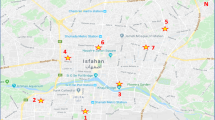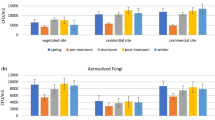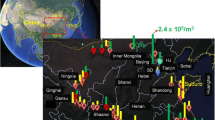Abstract
Exposure to bioaerosols can have adverse effects on human health and contribute to allergies, asthma, infectious diseases and pulmonary conditions. Bioaerosols are airborne particles of microbial, animal and plant origin. Animal- and plant-derived particles, which may disperse over long distances, are being increasingly addressed by environmental studies in addition to microorganisms. In this study, air samples were collected in various planned areas of three cities in China (Beijing, Hangzhou and Wuhan) using a new liquid-based sampler. Animal, plant and bacterial components were quantified according to the expression levels of housekeeping genes via real-time PCR and analysis of cycle threshold (Ct) values. The level of animal-derived particles in the air of Hangzhou was higher than those in the other two cities. More bacterial particles than animal or plant particles were detected in the air in Beijing compared with other cities. We also found a negative correlation between the bacterial content of bioaerosols and relative humidity and a positive correlation between bacterial content and temperature. By contrast, bioaerosol animal content was positively correlated with relative humidity and negatively correlated with temperature. In summary, high levels of bacterial particles were detected in atmospheric samples in China, although the lower concentrations of animal- and plant-derived particles should not be ignored. These data may provide important evidence for structural analyses of animal- and plant-derived bioaerosols as well as for risk assessment.







Similar content being viewed by others
References
Bertolini, V., Gandolfi, I., Ambrosini, R., Bestetti, G., Innocente, E., Rampazzo, G., et al. (2013). Temporal variability and effect of environmental variables on airborne bacterial communities in an urban area of Northern Italy. Applied Microbiology and Biotechnology, 97(14), 6561–6570.
Bowers, R. M., Clements, N., Emerson, J. B., Wiedinmyer, C., Hannigan, M. P., & Fierer, N. (2013). Seasonal variability in bacterial and fungal diversity of the near-surface atmosphere. Environmental Science and Technology, 47(21), 12097–12106.
Bowers, R. M., McLetchie, S., Knight, R., & Fierer, N. (2011). Spatial variability in airborne bacterial communities across land-use types and their relationship to the bacterial communities of potential source environments. The ISME journal, 5(4), 601–612.
Bragoszewska, E., & Pastuszka, J. S. (2018). Influence of meteorological factors on the level and characteristics of culturable bacteria in the air in Gliwice, Upper Silesia (Poland). Aerobiologia, 34(2), 241–255.
Brodie, E. L., DeSantis, T. Z., Parker, J. P. M., Zubietta, I. X., Piceno, Y. M., & Andersen, G. L. (2007). Urban aerosols harbor diverse and dynamic bacterial populations. Proceedings of the National Academy of Sciences of the United States of America, 104(1), 299–304.
Cao, C., Jiang, W., Wang, B., Fang, J., Lang, J., Tian, G., et al. (2014). Inhalable microorganisms in Beijing’s PM2.5 and pollutants during a severe smog event. Environmental Science and Technology, 48(3), 1499–1507.
Chien, Y. C., Chen, C. J., Lin, T. H., Chen, S. H., & Chien, Y. C. (2011). Characteristics of microbial aerosols released from chicken and swine feces. Journal of the Air and Waste Management Association, 61(8), 882–889.
Cox, R. N., & Clark, R. P. (1973). Natural-convection flow about the human body. Revue Generale de Thermique, 12(133), 11–19.
Després, V. R., Huffman, J. A., Burrows, S. M., Hoose, C., AleksandrS, S., Buryak, G., et al. (2012). Primary biological aerosol particles in the atmosphere: A review. Tellus B: Chemical and Physical Meteorology, 64(1), 145–153.
Diehl, K., Quick, C., Matthias-Maser, S., Mitra, S. K., & Jaenicke, R. (2001). The ice nucleating ability of pollen: Part I: laboratory studies in deposition and condensation freezing modes. Atmospheric Research, 58(2), 75–87.
Dybwad, M., Skogan, G., & Blatny, J. M. (2014). Temporal variability of the bioaerosol background at a subway station: Concentration level, size distribution, and diversity of airborne bacteria. Applied and environmental microbiology, 80(1), 257–270.
Esmaeil, N., Gharagozloo, M., Rezaei, A., & Grunig, G. (2014). Dust events, pulmonary diseases and immune system. American Journal of Clinical and Experimental Immunology, 3(1), 20–29.
Ferguson, R., Garcia-Alcega, S., Coulon, F., Dumbrell, A. J., Whitby, C., & Colbeck, I. (2019). Bioaerosol biomonitoring: Sampling optimization for molecular microbial ecology. Molecular ecology resources, 19(3), 672–690.
Fröhlich-Nowoisky, J., Kampf, C. J., Weber, B., Huffman, J. A., Pöhlker, C., Andreae, M. O., et al. (2016). Bioaerosols in the Earth system: Climate, health, and ecosystem interactions. Atomospheric Research, 182, 346–376.
Gabey, A. M., Vaitilingom, M., Freney, E., & Boulon, J. (2013). Observations of fluorescent and biological aerosol at a high-altitude site in central France. Atmospheric Chemistry and Physics, 13(15), 7415–7428.
Gandolfi, I., Bertolini, V., Ambrosini, R., Bestetti, G., & Franzetti, A. (2013). Unravelling the bacterial diversity in the atmosphere. Applied Microbiology and Biotechnology, 97(11), 4727–4736.
Gao, M., Yan, X., Qiu, T. L., Han, M. L., & Wang, X. M. (2016). Variation of correlations between factors and culturable airborne bacteria and fungi. Atmospheric Environment, 128, 10–19.
General Administration of Quality Supervision, Inspection and Quarantine of the People's Republic of China. (2003). Protocol of the real-time PCR for detecting genetically modified plants and their derived products. SN/T 1204—2003.
Goudie, A. S. (2014). Desert dust and human health disorders. Environment International, 63, 101–113.
Gu, X., Yao, L., Wang, L., et al. (2014). PCR detection method of plant ingredient in frozen surimi. Chinese Fishery Quality and Standards, 4(2), 44–49.
Haas, D., Galler, H., Luxner, J., & Zarfel, G. (2013). The concentrations of culturable microorganisms in relation to particulate matter in urban air. Atmospheric Environment, 65(2), 215–222.
Hallar, A. G., Chirokova, G., McCubbin, I., Painter, T. H., Wiedinmyer, C., & Dodson, C. (2011). Atmospheric bioaerosols transported via dust storms in the western United States. Geophysical Research Letters, 38, 2–7.
Harrison, R. M., Jones, A. M., Biggins, P. D., Pomeroy, N., Cox, C. S., & Kidd, S. P. (2005). Climate factors influencing bacterial count in background air samples. International Journal of Biometeorology, 49(3), 167–178.
Hebert, P. D. N., Cywinska, A., Ball, S. L., & deWaard, J. R. (2003). Biological identifications through DNA barcodes. Proceedings: Biological Sciences, 270(1512), 313–321.
Helin, A., Sietiö, O. M., Heinonsalo, J., Bäck, J., Riekkola, M. L., & Parshintsev, J. (2017). Characterization of free amino acids, bacteria and fungi in size-segregated atmospheric aerosols in boreal forest: Seasonal patterns, abundances and size distributions. Atmospheric Chemistry and Physics, 17, 13089–13101.
Huang, J., & Xie, Z. (2009). Analysis for monitoring vegetation coverage change of Wuhan based on remote sensing data of MODIS. Meteorological and Environmental Science, 32(2), 16–20.
Huffman, J. A., Prenni, A. J., DeMott, P. J., Pöhlker, C., Mason, R. H., Robinson, N. H., et al. (2013). High concentrations of biological aerosol particles and ice nuclei during and after rain. Atmospheric Chemistry and Physics, 13, 6151–6164.
Huffman, J. A., Sinha, B., Garland, R. M., & Sneepollmann, A. (2012). Size distributions and temporal variations of biological aerosol particles in the Amazon rainforest characterized by microscopy and real-time UV-APS fluorescence techniques during AMAZE-08. Atmospheric Chemistry and Physics, 12(12), 11997–12019.
Humbal, C., Gautama, S., & Trivedib, U. (2018). A review on recent progress in observations, and health effects of bioaerosols. Environment International, 118, 189–193.
Hurtado, L., Rodríguez, G., Lopez, J., Castillo, J. E., Molina, L., Zavala, M., et al. (2014). Characterization of atmospheric bioaerosols at 9 sites in Tijuana Mexico. Atmospheric Environment, 96(7), 430–436.
Hu, D., Wang-Li, L., Simmons, O. D., III., Classen, J. J., & Osborne, J. A. (2015). Spatiotemporal variations of bioaerosols in the vicinity of an animal feeding operation facility in the US. Journal of Environmental Protection, 6, 614–627.
Innocente, E., Squizzato, S., Visin, F., Facca, C., Rampazzo, G., Bertolini, V., et al. (2017). Influence of seasonality, air mass origin and particulate matter chemical composition on airborne bacterial community structure in the Po Valley, Italy. Science of The Total Environment, 593–594, 677–687.
Iversen, M., (1999). Humans effects of dust exposure in animal confinement buildings. Proceedings of the Dust control in animal production facilities International Symposium, Jutland, Denmark, 131–139.
Jaenicke, R. (2005). Abundance of cellular material and proteins in the atmosphere. Science, 308(5718), 73.
Jia, X., Yan, P., Dong, P., Zhang, X., Li, Y., & Guo, W. (2018). Variations of PM mass concentration at Chaoyang Stie in Beijing during. Meteorological Monthly, 44(11), 1489–1500.
Jochner, S., Lüpke, M., Laube, J., Weichenmeier, I., Pusch, G., Traidl-Hoffmann, C., et al. (2015). Seasonal variation of birch and grass pollen loads and allergen release at two sites in the German Alps. Atmospheric Environment, 122, 83–93.
Jones, A. M., & Harrison, R. M. (2004). The effects of meteorological factors on atmospheric bioaerosol concentrations - a review. Science Total Environmental, 326, 151–180.
Lee, B. U., Lee, G., & Heo, K. J. (2016). Concentration of culturable bioaerosols during winter. Journal of Aerosol Science, 94, 1–8.
Li, Z. (2017). Temporal and spatial distribution of PM2.5 and PM10 and correlation of particulate matters and meteorological factors in Wuhan. Journal of Green Science and Technology, 10, 66–71.
Lo, E., & Levetin, E. (2007). Influence of meteorological conditions on early spring pollen in the Tulsa atmosphere from 1987–2006. Journal of Allergy and Clinical Immunology, 119(1), S101.
Lutgring, K. R., Linton, R. H., Zimmerman, N. J., Peugh, M., & Heber, A. J. (1997). Distribution and quantification of bioaerosols in poultry-slaughtering plants. Journal of Food Protection, 60(7), 804–810.
Lu, Z., Wu, C., Yue, W., Feng, K., & Huang, M. (2010). The assessment on residential ecological environment in the central city of Hangzhou. Acta Ecologica Sinica., 30(11), 2856–2863.
Lu, R., Li, Y. P., Li, W. X., Xie, Z. S., Fan, C. L., Liu, P. X., et al. (2018). Bacterial community structure in atmospheric particulate matters of different sizes during the haze days in Xi’an, China. Science of The Total Environment, 637–638, 244–252.
Lu, S., Wu, Y., & Wang, Y. (2018). Analysis on the characteristics of spatial and temporal distribution and cause in Hangzhou PM2.5. Journal of Mudanjiang University, 27(4), 43–46.
Maki, T., Hara, K., Kobayashi, F., Kurosaki, Y., Kakikawa, M., Matsuki, A., et al. (2015). Vertical distribution of airborne bacterial communities in an asian-dust downwind area, noto peninsula. Atmospheric Environment, 119, 282–293.
Maron, P. A., Lejon, D. P. H., Carvalho, E., Bizet, K., Lemanceau, P., Ranjard, L., et al. (2005). Assessing genetic structure and diversity of airborne bacterial communities by DNA fingerprinting and 16S rDNA clone library. Atmospheric Environment, 39(20), 3687–3695.
Ma, J., Li, C., Kwan, M., & Chai, Y. (2018). A multilevel analysis of perceived noise pollution, geographic contexts and mental health in Beijing. Int J Environ Res Public Health, 15(7), 1479.
Ma, M., Xu, F., & Dang, A. (2019). Study on the spatial temporal change of vegetation coverage between the belts of Beijing’s main urban area based on dynamic remote sensing data. Journal of Environmental Engeering Technology, 9(4), 404–413.
Ma, Z., Zhang, H., & Zhang, J. (2009). The analysis on vegetation coverage of Hangzhou based on MODIS system. Journal of Anhui Agri Sci, 34(18), 4618–4619.
Millner, P. D. (2009). Bioaerosols associated with animal production operations. Bioresource Technology, 100(22), 5379–5385.
Morris, C. E., Conen, F., Alex, H. J., Phillips, V., Pöschl, U., & Sands, D. C. (2014). Bioprecipitation: A feedback cycle linking earth history, ecosystem dynamics and land use through biological ice nucleators in the atmosphere. Global Change Biology, 20(2), 341–351.
Mouli, P. C., Mohan, S. V., & Reddy, S. J. (2005). Assessment of microbial (bacteria) concentrations of ambient air at semi-arid urban region: Influence of meteorological factors. Applied Ecology and Environmental Research, 3(2), 139–149.
Ortiz-Martínez, M. G., Rodríguez-Cotto, R. I., Ortiz-Rivera, M. A., Pluguez-Turull, C. W., & Jiménez-Vélez, B. D. (2015). Linking endotoxins, African dust PM10 and asthma in an urban and rural environment of Puerto Rico. Mediators of Inflammation. https://doi.org/10.1155/2015/784212.
Park, J., Li, P. F., Ichijo, T., Nasu, M., & Yamaguchi, N. (2018). Effects of Asian dust events on atmospheric bacterial communities at different distances downwind of the source region. Journal of Environmental Sciences, 72, 133–139.
Pöschl, U. (2005). Atmospheric aerosols: Composition, transformation, climate and health effects. Angewandte Chemie International Edition, 37(7), 7520–7540.
Radonić, A., Thulke, S., Mackay, I. M., Landt, O., Siegert, W., & Nitsche, A. (2004). Guideline to reference gene selection for quantitative real-time PCR. Biochemical and Biophysical Research Communications, 313(4), 856–862.
Šantl-Temkiv, T., Gosewinkel, U., Starnawski, P., Lever, M., & Finster, K. (2018). Aeolian dispersal of bacteria in Southwest Greenland: Their sources, abundance, diversity and physiological states. FEMS Microbiology Ecology, 94, 1–10.
Serrano-Silva, N., & Calderón-Ezquerro, M. C. (2018). Metagenomic survey of bacterial diversity in the atmosphere of Mexico City using different sampling methods. Environmental Pollution, 235, 20–29.
Shen, Q., Qin, J., & Cao, L. (2011). Quantitative Classification and Ordination of Shrub-grass Vegetation on Hangzhou’s Xixi Wetland. Journal of Zhejiang International Studies University., 4, 92–100.
Skotak, K., Degorska, A., Ulanczyk, R., & Pecka, T. (2016). Carbonaceous aerosol. An indicator of the human activity impact on environment and health. Przemysl Chemiczny, 95(3), 548–553.
Smets, W., Moretti, S., Denys, S., & Lebeer, S. (2016). Airborne bacteria in the atmosphere: presence, purpose, and potential. Atmospheric Environment, 139, 214–221.
Song, B., Sun, Y., & Xu, D. (2018). Distribution of artemisia pollen and its effect on airway responsiveness in patients with allergic rhinitis. Chinese Medical Digest, 33(5), 385–387.
Song, G., Zheng, X. (2012). The Analysis on types and environmental functions of the wetland in Zhejiang province. 2012 2nd International Conference on Applied Social Science, 361–366.
Straumfors, A., Heldal, K. K., Eduard, W., Wouters, I. M., Ellingsen, D. G., & Skogstad, M. (2016). Cross-shift study of exposure–response relationships between bioaerosol exposure and respiratory effects in the Norwegian grain and animal feed production industry. Occupational and Environmental Medicine, 73(10), 685–693.
Tang, Z., Zeng, X., & Zhao, H. (2019). Research on tree array landscape in urban open space of Hangzhou and Its Influence on environment factors in summer. Journal of Chinese Forestry., 17(2), 1–5.
Tong, Y., & Lighthart, B. (2000). The annual bacterial particle concentration and size distribution in the ambient atmosphere in a rural area of the Willamette Valley Oregon. Aerosol Science Technology, 32, 393–403.
Uetake, J., Tobo, Y., Uji, Y., Hill, T. C. J., DeMott, P., Kreidenweis, S., & Misumi, R. (2019). Seasonal changes of airborne bacterial communities over tokyo and influence of local meteorology. Front Microbiol., 10, 1572.
Veillettea, M., Bonifaita, L., Mbarechea, H., Marchandb, G., & Duchainea, C. (2018). Preferential aerosolization of Actinobacteria during handling of composting organic matter. Journal of Aerosol Science, 116, 83–91.
Walser, S. M., Gerstnera, D. G., Brennera, B., Büngerb, J., Eikmannc, T., Janssena, B., et al. (2015). Evaluation of exposure–response relationships for health effects of microbial bioaerosols–A systematic review. International Journal of Hygiene and Environmental Health, 218(7), 577–589.
Wan, S. H. (2015). The study of universal real-time PCR detection methods for polluted microorganisms in food. South China University of Technology. 1–6.
Wang, Q., Ge, J., Xu, X., & Wu, Z. (2009). Research on vegetation coverage in Wuhan Donghu. Science and Technology Innovation Herald, 8, 223–224.
Wittmaack, K., Wehnes, H., Heinzmann, U., & Agerer, R. (2005). An overview on bioaerosols viewed by scanning electron microscopy. Science of the Total Environment, 346(1–3), 244–255.
Womack, A. M., Bohannan, B. J. M., & Green, J. L. (2010). Biodiversity and biogeography of the atmosphere. Philosophical Transactions: Biological Sciences, 365(1558), 3645–3653.
Wu, Y., Chan, C., & Chew, G. L. (2012). Meteorological factors and ambient bacterial levels in a subtropical urban environment. International Journal of Biometeorology, 56, 1001–1009.
Xie, Z. S., Fan, C. L., Lu, R., Liu, P. X., Wang, B. B., Du, S. L., et al. (2018). Characteristics of ambient bioaerosols during haze episodes in China: A review. Environmental Pollution, 243, 1930–1942.
Xie, Z., Li, Y., Lu, R., Li, W., Fan, C., Liu, P., et al. (2018). b). Characteristics of total airborne microbes at various air quality levels. Journal of Aerosol Science, 116, 57–65.
Yamaguchi, N., Ichijo, T., Sakotani, A., Baba, T., & Nasu, M. (2012). Global dispersion of bacterial cells on Asian dust. Scientific Reports, 2, 525.
Yoo, K., Lee, T. K., Choi, E. J., Yang, J., Shukla, S. K., Hwang, S., et al. (2017). Molecular approaches for the detection and monitoring of microbial communities in bioaerosols: A review. Journal of Environmental Sciences, 51, 234–247.
Zhai, Y., Li, X., Wang, T., Wang, B., Li, C., & Zeng, G. (2018). A review on airborne microorganisms in particulate matters: Composition, characteristics and influence factors. Environment International, 113, 74–90.
Zhen, Q., Deng, Y., Wang, Y., Wang, X., Zhang, H., Sun, X., et al. (2017). Meteorological factors had more impact on airborne bacterial communities than air pollutants. Science of the Total Environment, 601–602, 703–712.
Zhou, W. (2018). Study on plant landscape of birds habitat in urban green space at City parks in Hangzhou. Zhejiang Agriculture and Forestry University Master Degree Thesis. 54–57.
Acknowledgements
This study was supported by a Grant (2016YFF0103103) from the National Key R&D Program of China, the Chinese Academy of Inspection and Quarantine (CAIQ 2018JK015) and the National Key R&D Program of China (2018ZX10101003-002-004). Special thanks are due to all personnel involved in completing the experiments.
Author information
Authors and Affiliations
Corresponding authors
Ethics declarations
Conflict of interest
The authors declare that they have no conflicts of interest.
Informed consent
Informed consent was obtained from all individual participants included in the study.
Supplementary information
Below is the link to the electronic supplementary material.
Supplementary file 1
Graph of housekeeping gene amplification in collected samples. (a) Animal-derived amplification, (b) plant-derived amplification, and (c) bacteria. (TIF 4246kb)
Rights and permissions
About this article
Cite this article
Ma, X., Zhang, Q., Liu, K. et al. Spatial distribution of atmospheric bioaerosols in Beijing, Hangzhou and Wuhan, China. Aerobiologia 37, 155–170 (2021). https://doi.org/10.1007/s10453-020-09680-6
Received:
Accepted:
Published:
Issue Date:
DOI: https://doi.org/10.1007/s10453-020-09680-6




